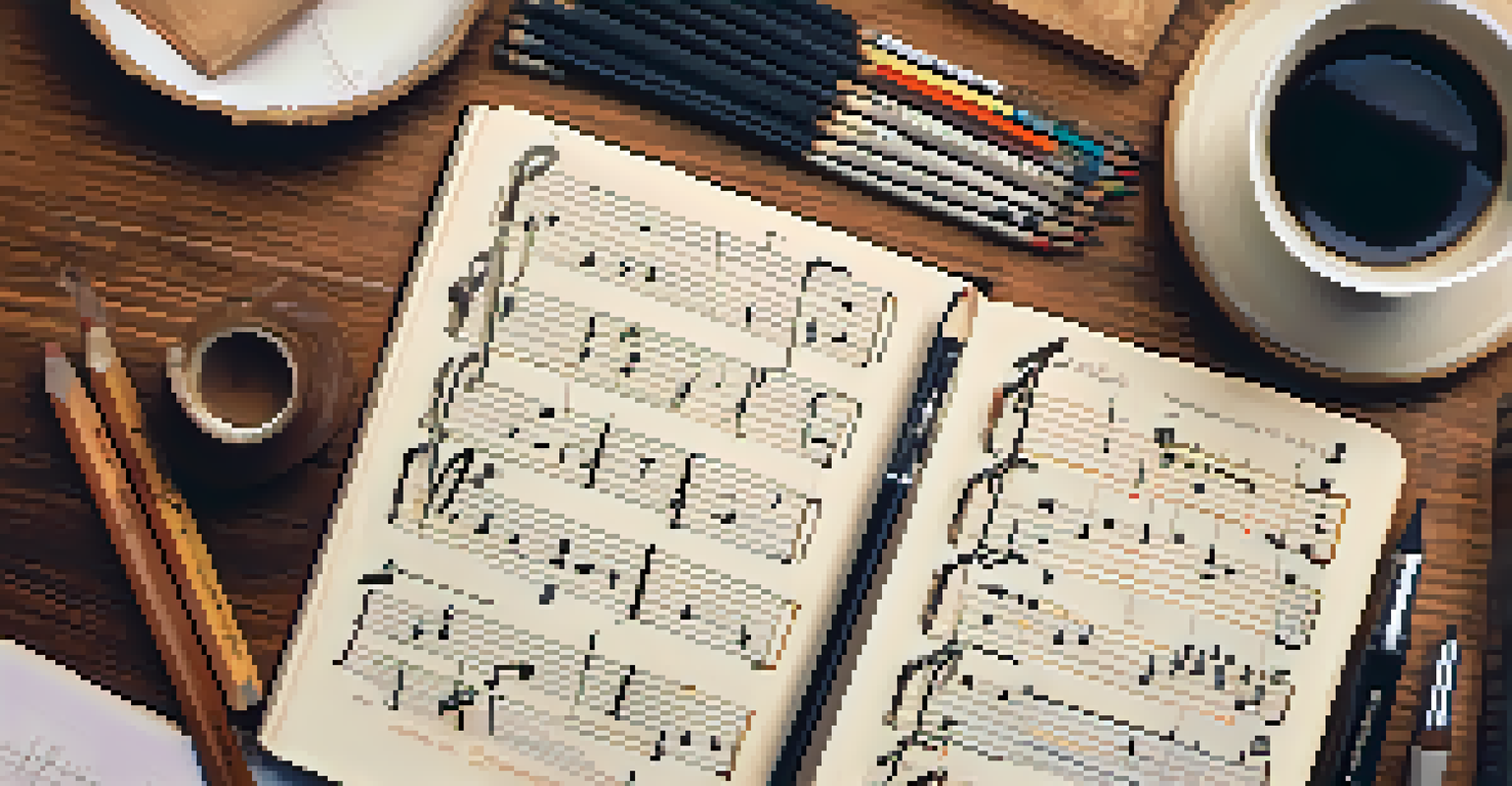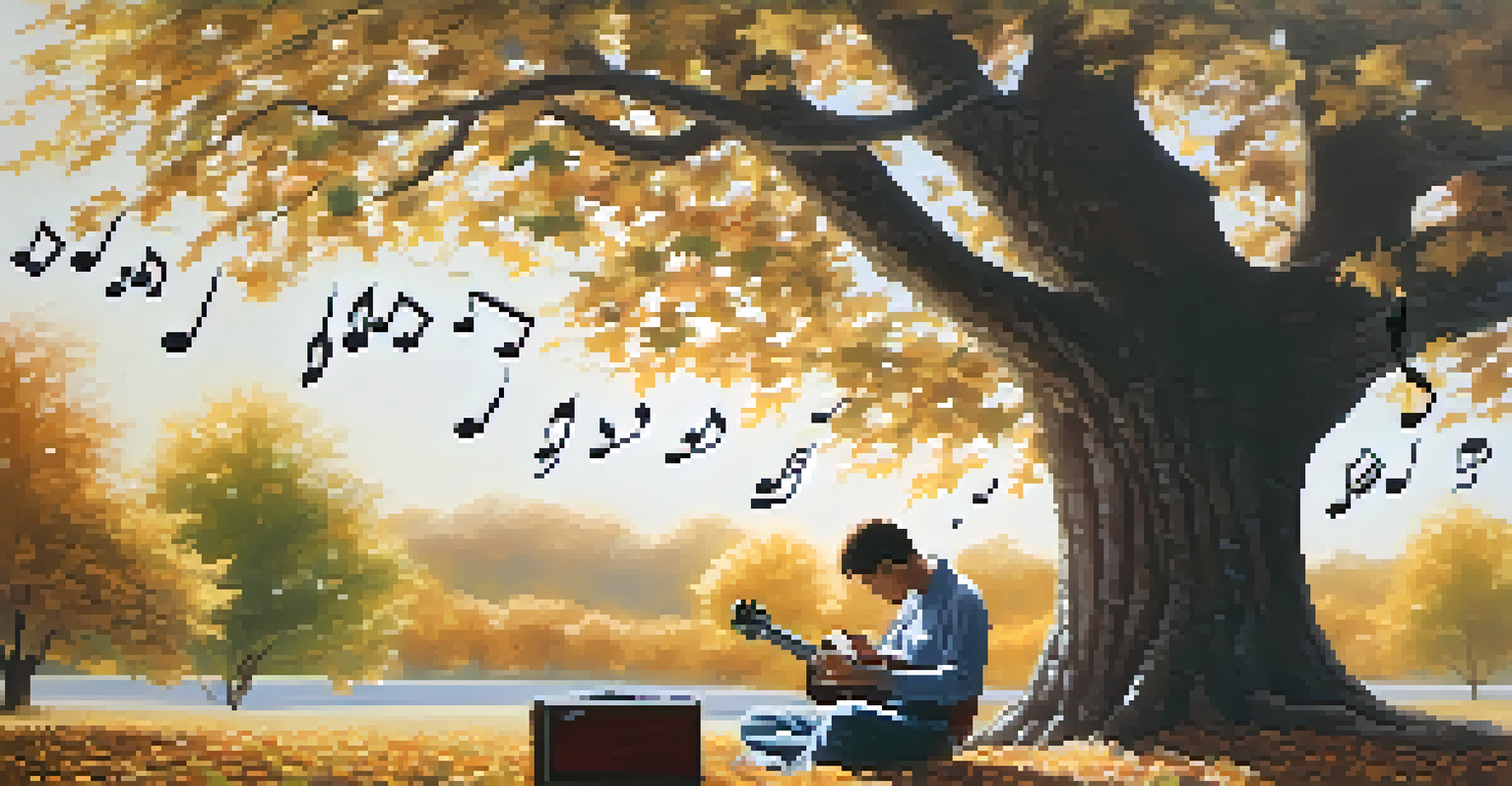Understanding Notation: A Guide for Guitar Transcribers

What is Musical Notation and Why It Matters
Musical notation serves as the universal language for musicians, allowing them to communicate and share their ideas. For guitar transcribers, understanding this notation is crucial to accurately capture the essence of a piece. Whether you're jotting down a solo or transcribing a full arrangement, notation helps preserve the intricacies of music.
Without music, life would be a mistake.
Think of notation as a map for musicians; just as a map guides travelers to their destination, notation guides musicians in playing a piece correctly. Without it, the beauty of music could easily be lost in translation. This is especially important for guitarists who often play complex solos that need precise articulation.
In essence, mastering musical notation opens up a world of possibilities for guitarists. It allows you to interpret and communicate music effectively, which is vital for collaboration and performance. Plus, it enhances your ability to learn from other musicians, making you a more versatile player.
Understanding the Basics of Staff and Clefs
At the heart of musical notation lies the staff, a set of five horizontal lines where notes are placed to indicate pitch. For guitarists, the treble clef is most commonly used, signifying higher pitches. Familiarizing yourself with how notes are arranged on the staff is the first step toward effective transcribing.

You might think of the staff as a ladder; each rung represents a different note. The notes that sit on the lines and spaces correspond to specific pitches, and learning to read these is essential for transcribing. For example, the notes on the lines of the treble clef from bottom to top are E, G, B, D, and F.
Musical Notation as a Universal Language
Musical notation allows musicians to effectively communicate and share their ideas, preserving the essence of a piece.
Understanding the staff and clefs also sets the foundation for more complex concepts in notation. Once you grasp this, you can begin to recognize how different notes and symbols contribute to the overall musical picture. This foundational knowledge enables you to approach transcriptions with confidence and accuracy.
Notes, Rests, and Their Importance in Transcribing
In musical notation, notes represent sound, while rests indicate silence. Recognizing the different types of notes—whole, half, quarter, and so on—is vital for capturing the rhythm and flow of a piece. For guitar transcribers, getting this right ensures that the music sounds just as it was intended.
Music can change the world because it can change people.
Imagine trying to bake a cake without measuring the ingredients; the result would be a disaster. Similarly, if you neglect the rhythm by ignoring rests or using the wrong note values, your transcription may not resonate with listeners. Each note and rest has its place, creating a balance that artists strive to achieve.
By incorporating both notes and rests accurately, you create a transcription that reflects the original work's dynamics. This attention to detail not only enhances your skills but also builds your credibility as a transcriber. Remember, music is as much about the spaces between notes as it is about the notes themselves.
Exploring Time Signatures and Their Role
Time signatures are like the heartbeat of a piece, dictating how many beats are in each measure. Common signatures like 4/4 and 3/4 provide a framework for understanding the rhythm structure. For guitar transcribers, knowing the time signature helps inform the overall feel and tempo of the music.
Think of it this way: if musical notation is a recipe, the time signature is the cooking time. It sets the pace at which you should play the notes, making it essential to acknowledge in your transcriptions. Misinterpreting a time signature can lead to a performance that feels off or rushed.
Understanding Staff and Clefs Basics
Familiarity with the staff and clefs is essential for guitarists, as it forms the foundation for accurate transcribing.
By mastering time signatures, you gain a deeper appreciation for the music's rhythm and flow. This understanding will not only improve your transcriptions but also enhance your playing skills. As you become more confident in your grasp of time signatures, you’ll find that your transcriptions start to come alive.
Dynamics and Articulation: Adding Emotion to Your Transcriptions
Dynamics in music notation indicate the volume at which notes should be played, adding emotional depth to a piece. Whether it’s a gentle piano (soft) or a powerful forte (loud), these markings guide the performer in conveying the intended feelings of the music. For transcribers, including dynamics is vital for capturing the original artist's expression.
Articulation marks, such as staccato or legato, further enhance this emotional quality. They tell you how to play the notes—short and detached or smooth and connected. Utilizing these markers in your transcriptions ensures that you’re not just writing down notes, but also the character of the music.
Incorporating dynamics and articulation into your transcriptions allows you to create a more faithful representation of the original work. This added layer of nuance makes your transcriptions resonate more with musicians and listeners alike. Ultimately, it transforms a simple notation into a vibrant interpretation of the music.
Using Tablature: A Guitarist's Best Friend
Tablature, or 'tab,' is a popular form of notation specifically designed for stringed instruments like the guitar. Unlike traditional notation, tablature represents the strings and frets directly, making it more accessible for guitarists. This straightforward approach allows players to learn songs quickly without needing to read standard notation.
Imagine having a map that shows you exactly where to step; that's what tablature does for guitarists. Each number on the lines corresponds to a fret on the guitar, so you can easily see where to place your fingers. This visual representation can significantly speed up the learning process for beginners and even seasoned players.
Importance of Dynamics and Articulation
Incorporating dynamics and articulation into transcriptions adds emotional depth, making the music more expressive and true to the original work.
While tablature is a fantastic tool, remember to use it in conjunction with standard notation. Combining both methods allows for a more comprehensive understanding of the music. As a transcriber, being able to read both forms will make your work more versatile and beneficial to a wider audience.
Practical Tips for Effective Guitar Transcription
Transcribing music can feel daunting, but breaking it down into manageable steps can simplify the process. Start by listening to a section of the piece multiple times before attempting to write it down. This will help you internalize the melody and rhythm, making it easier to capture the nuances of the performance.
Next, consider using software or tools that can slow down recordings without altering the pitch. This allows you to hear each note clearly, making the transcription process smoother. Annotating your work along the way can also help clarify your thoughts and ensure you’re capturing each detail accurately.

Finally, don’t hesitate to seek feedback from fellow musicians. Sharing your transcriptions can provide valuable insights and help you refine your skills. Over time, practice and collaboration will lead to improved accuracy and a greater understanding of musical notation.